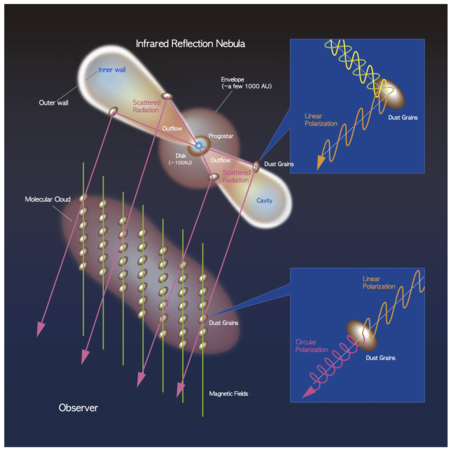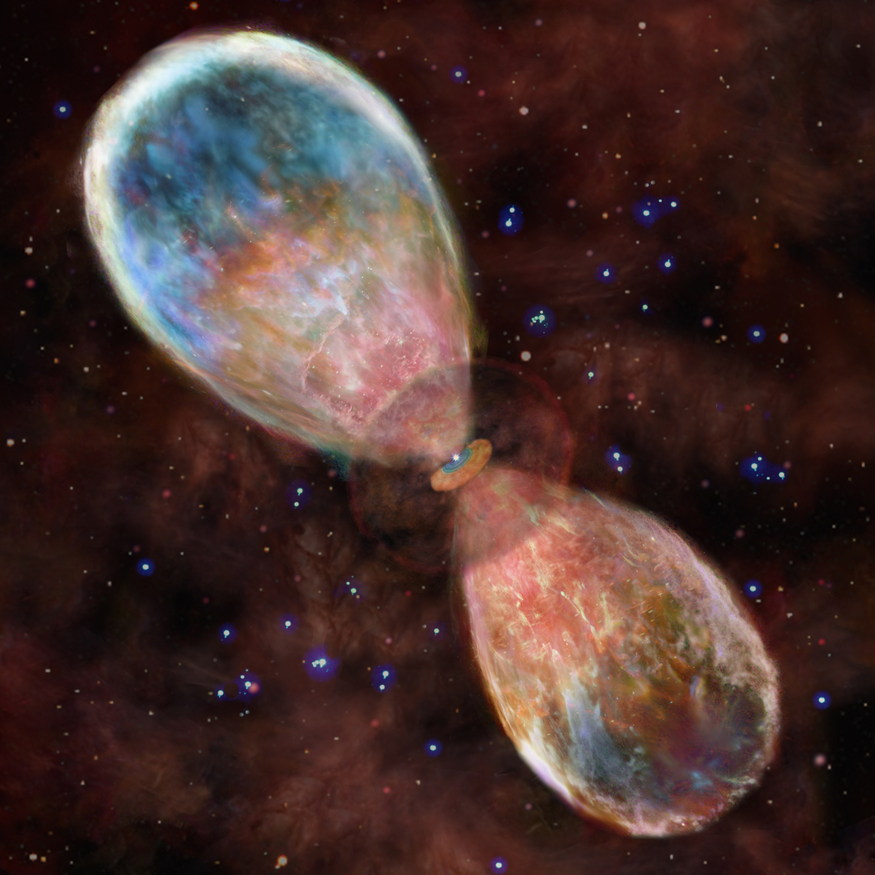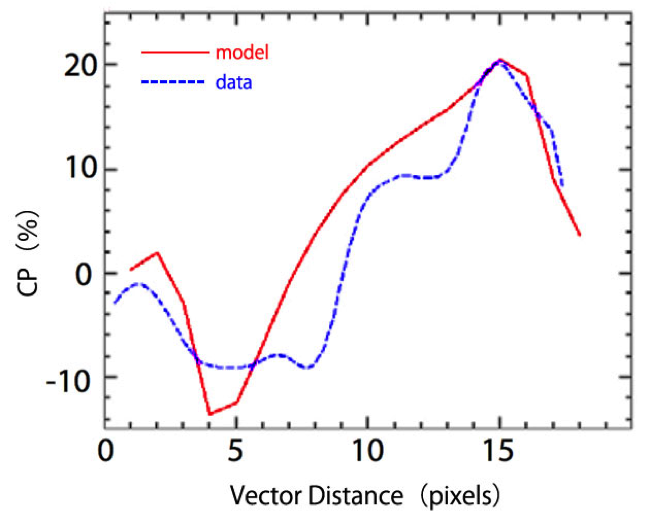Universality of circular polarization in star- and planet-forming regions: Implications for the origin of homochirality of life
【Research outline】
A research team with Jungmi KWON (GUAS/NAOJ) has performed deep imaging linear and circular polarimetry (Note 1) of the ‘Cat's Paw Nebula’ (NGC 6334) (Note 2) located in the constellation Scorpius, successfully detecting high degrees of circular polarization (CP) of as much as 22% in NGC 6334. The detected CP degree is the highest ever observed.
In addition, the team has presented the first systematic survey of a combination of linear and circular polarimetry in nine star- and planet-forming regions. As the results of statistical analysis of observations of various star-forming regions, CPs were detected in nine star- and planet-forming regions. Putting it differently, it can be said that CP is a universal feature of star- and planet-forming regions. The team’s findings enable us to obtain information about magnetic fields of circumstellar structures around protostars, which is difficult to obtain using existing methods. There is a hypothesis that large CP causes homochirality (Note 3) of amino acids and that left-handed amino acids come from outer space. The team’s findings imply an extraterrestrial origin of homochirality of life, from the universality of CP detected in star- and planet-forming regions.
This research is part of an ongoing survey project of wide-field near-infrared (JHKs) imaging polarimetry for star-forming regions (PI: Motohide TAMURA, University of Tokyo/NAOJ). Doctoral student Jungmi KWON, who is contributing to the project, led this research with nine international researchers from Japan and the United Kingdom. The team’s findings were published in the Astrophysical Journal Letter on March 1, 2013.
[Notes] (1) An instrument used for observations is the IRSF (InfraRed Survey Facility), a 1.4 m telescope with a built-in SIRPOL imaging polarimeter at an elevation of about 1761 meters at the South African Astronomical Observatory in Sutherland, South Africa. The field of view (~ 8 x 8 arcmin2) enables us to observe a wide field in the three (JHKs) bands simultaneously. (2) The ‘Cat's Paw Nebula’ is a star- and planet-forming region located in the constellation Scorpius. It is approximately 5,500 light years distant from the Earth. (3) A chiral molecule (from the Greek word for ‘hand’) is a molecule that cannot be superimposed on its own mirror image. A hand is chiral in the sense that the mirror image of a left hand is a right hand, and the two hands cannot be superimposed. All the vital biomolecules of life possess the same handedness (left-handedness); this is called homochirality.
<Research Background>
What is the origin of life on Earth? Where did life on Earth come from? Research into star and planet formation throws new light on on these questions and arouses public curiosity.
The Cat’s Paw Nebula is located in the galactic plane of our Milky Way Galaxy, and it is 5,500 light years away from the Earth. The nebula is known to be one of the most active star-forming regions in the Milky Way Galaxy, containing many young stars of the Sun’s mass, born about one million years ago. Even though tens of thousands of young stars are also embedded in the Cat’s Paw Nebula, the stars cannot be seen in optical wavelengths because they are buried inside the optically thick (molecular or dark) clouds of gas and dust. For this reason, our research team used near-infrared to observe the site where stars and planets are being born. Infrared light enables us to look at regions that are heavily obscured in the optical wavelengths. This means that we can expect to hear the story about the trip photons in the infrared make to observers on the face of the Earth from heavenly bodies in space in the same way as photons from stars experience.
Furthermore, a unique characteristic of light called ‘polarimetry’ enables us not only to obtain information of the intensity of near-infrared from illuminating sources, but also that of (linearly or circularly) polarized light. The properties of polarized light, an important tool in astronomy, have even been the focus of astrobiology―the study of life in the universe (Figure 1). Origin-of-life theories often ignore the homochirality problem, even though the question is critical to the origin of life. Scientists hypothesized that the enantiomeric excess of L-amino acids in extraterrestrial sources could be due to circular polarization, which selectively destroys one enantiomer. In previous studies in 1998, an extended CP region was reported in the Orion nebula. It was the only example to show extended and high CP, and there is no observation to study the universality of CP obtained from space, not in laboratories on Earth. The reason is that there were no instruments available to detect any circularly polarized light with wide field of view and high sensitivity.
< Results from near-infrared polarimetric observations>
The history of star and planet formation and the origin of life are still a mystery, and the team with Jungmi KWON who belongs to GUAS, NAOJ, and JSPS is involved in working out the puzzle. To solve the puzzle, the team used the IRSF 1.4 m telescope with SIRPOL imaging polarimeter at the South African Astronomical Observatory in Sutherland (at an elevation of about 1761 meters), which is the one of the coldest places in South Africa. The telescope and instrument are operated by Nagoya University, Kyoto University, and NAOJ. SIRPOL is an instrument developed by our group; it enables us to obtain information of circularly polarized light as well as linearly polarized light. It also enables wide-field (~ 8 x 8 arcmin square in the sky = ~ 1/4 diameter of the moon) imaging polarimetry, which is a decidedly broader scope than other existing instruments. In other words, IRSF/SIRPOL has one of the highest performances in the present for (linearly and/or circularly) polarized light in the near-infrared toward a wide field of view of the sky.
The observations caught scattered lights of dust grains, as material of reflection nebulae around young massive stars, from an illuminating source. The data show the following features: (1) infrared reflection nebula around the central source, (2) hourglass-shaped outflow, (3) quadrupolar patterns of CP extended to the outside of circumstellar structures broader than the outflow, (4) the highest CP degree (22%) so far observed in star-forming regions, and (5) the maximum CP extents (about 600 times of the size of our solar system).
The young massive star that is the illuminating source of the reflected bipolar nebula is located around the center of each side of the nebula. Even though it is obstructed by optically thick gas and disk in near-infrared, it can be observed in mid-infrared (longer wavelength). Our linear polarimetry data that enable us to know the size of the reflection nebulae as well as the position of the central source also indicate the existence and location of the illuminating source in this bipolar nebula.
The team’s findings toward the massive star-forming region NGC 6334-V in the Cat’s Paw Nebula suggest a unique characteristic of light named CP is extended over more than the Orion nebula that was the largest CP region ever detected until the team found CP in the Cat’s Paw Nebula. Furthermore, the team firstly detected very clear quadrupolar pattern with the highest CP degree. This is a scientific breakthrough in CP observations of star-forming regions.
The team also performed survey observations of polarized light in various star-forming regions, and the researchers successfully detected CP in nine star- and planet-forming regions such as Orion, Taurus, Chamaeleon, etc. There are only three regions to show large CP greater than 2 % in the previous studies of CP in star-forming regions. Until now, since the number of CP observations and successful detection was too small, statistical debate on the characteristic of CP in star-forming regions was not reached. The team’s findings present CP is greater than 2 % in all intermediate and massive star-forming regions, and suggest massive star-forming regions with large luminosities tend to large and extended CP. These are the first systematic results obtained from the infrared circular polarization survey with the unique instrument.
<A comparison with observations and models>
The team not only performed observations but also three-dimensional Monte Carlo simulations. The simulations reveal the mechanism of large CP (22%) shown in observations. The idea is that photons are released from a central star, and we trace and estimate the interaction between the light and surrounding structures numerically. In existing mechanisms of CP, even though multiple scattering was mainly considered as the mechanism to generate CP, it cannot generate large CP over 1 %. The team’s findings using the three-dimensional Monte Carlo simulations suggest (1) light from the illuminating source of reflection nebulae is scattered by circumstellar structures, (2) the scattered light is circularly polarized by dust grains aligned with the magnetic field (dichroic extinction). It successfully reproduces large CP such as that over 20% (Figure 4) as well as the quadrupolar patterns of CP.

|

|
| Figure 3: Polarization Mechanism (Credit: National Astronomical Observatory of Japan) | Artist's rendition of an outflow. (Credit: National Astronomical Observatory of Japan) |

|
Figure 4 :Line profile of circular polarization. A solid line shows our model result, and a dashed line shows observational data.
(Credit: National Astronomical Observatory of Japan) |
<Intimation of the relationship between huge CP in massive star-forming regions and life in the Solar system>
Life on Earth is made of “left-handed amino acids (L-amino acids)”. The question of why organisms on Earth consist of L-amino acids instead of D-amino acids or consist of D-sugar instead of L-sugar is still an unresolved riddle. In other words, a major mystery of life on Earth is that organisms are exclusively made up of left-handed amino acids. Therefore, the effort to solve this problem is one of the biggest in research into the origins of life, a subject that remains enveloped in mystery.
What kind of mechanism causes the selection of all L-amino acids? One of the mainstream hypotheses today is this: photolysis of one enantiomer of a racemic amino acid with circularly polarized light, transfer of chirality from enantioenriched amino acids to proteinogenic amino acids, and aqueous amplification of one enantiomer with preferential dissolution. Thus, how the circularly polarized light physically works is important in determining the hypothesis of an extraterrestrial origin of homochirality or the origin of abiogenesis on Earth. For the hypothesis of an extraterrestrial origin, CP of synchrotron radiation in neutron stars has emerged as a candidate for extraterrestrial sources. Recently, CP detected in the Orion nebula has been mentioned as the strongest candidate, as originally suggested by Jeremy Bailey at The University of New South Wales and his collaborators. On the basis of such a hypothesis, the scenario below can be conjectured.
“Above all, organic material such as amino acids is made in a molecular cloud. Next, any initial surplus of L-amino acids is initiated by CP. The L-amino acids are transferred to parent meteorites or comets when the solar system is formed, and they are eventually transported to Earth. In the prebiotic sea, a small amount of surplus of L-amino acids is amplified by an amplifying action such as a Soai response. At the end of such a process, life is born with homochirality of amino acids.”
In connection with the team’s findings, the suggested scenario is that (1) the solar system is formed in massive star-forming regions such as the Cat's Paw Nebula and Orion nebula, (2) the solar system is swallowed up in the huge CP region, (3) amino acids, completely affected by one side of the CP region, are biased towards L-amino acids, and then (4) the L-amino acids are finally carried to Earth with meteorites, comets, etc. However, since debates continue about transmutation of meteorites in the hypothesis of an extraterrestrial origin, improved observations, experiments, and theories are being sought.
<Summary Including Current and Future Positions >
The research team successfully detected high degrees of CP (22%) in the nebula including young stars. The detected CP degree is the highest among CPs reported in star-forming regions. The team also shed light on the mechanism of CP. From this, CP has become a new tool with which to obtain information about the effects of magnetic fields and circumstellar structures that can affect the process of star and cluster formation. Furthermore, both the CP detection that is not only higher but also broader than in the Orion nebula and the universality of CP in various star-forming regions imply that Orion is not the only candidate for CP as the extraterrestrial origin of homochirality on life. Putting it differently, in star- and planet-forming regions, CP may be a common feature. These findings are among the latest knowledge obtained using the unique method called ‘wide-field near-infrared imaging polarimetry observations’.
‘Astrobiology’ that builds on technological and scientific capability is expected to open doorways to new knowledge in many fields, with the progress of extrasolar planet observations and solar system research. Hereafter, the research team will continue its wide-field CP survey of star- and planet-forming regions and make new attempts to conduct high-resolution observations of CP. The team’s findings using polarized light toward star- and planet-forming regions are expected to provide the basis for another ongoing project, the Subaru Strategic Exploration of Exoplanets and Disks with HiCIAO/AO188 (SEEDS).
<Research Paper Source>
- - Kwon, J. et al. 2013, Astrophysical Journal Letter 765, L 6, “Near-Infrared Circular Polarization Images of NGC 6334-V”
- Kwon, J. 2013, The Graduate University for Advanced Studies, PhD thesis
<Research Team>
Jungmi KWON (National Astronomical Observatory of Japan/Graduate University for Advanced Studies, First author), Motohide TAMURA (National Astronomical Observatory of Japan/Graduate University for Advanced Studies, Tokyo University), Phil W. LUCAS (University of Hertfordshire), Jun HASHIMOTO (National Astronomical Observatory of Japan), Nobuhiko KUSAKABE (National Astronomical Observatory of Japan), Ryo KANDORI (National Astronomical Observatory of Japan), Yasushi NAKAJIMA (Hitosubashi University), Takahiro NAGAYAMA (Nagoya University), Tetsuya NAGATA (Kyoto University), James H. HOUGH (University of Hertfordshire)
<Information About Research Funding>
This work is supported by the JSPS Research Fellowships for Young Scientists (24-110) and MEXT (Grants-in-Aid 19204018 and 22000005).

